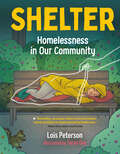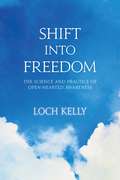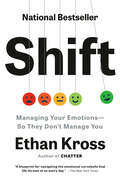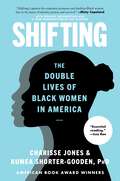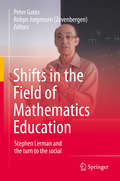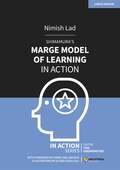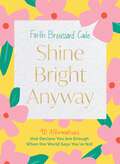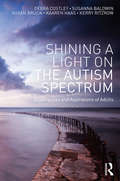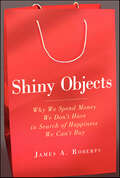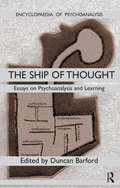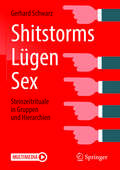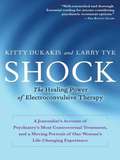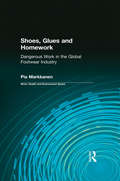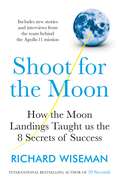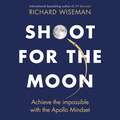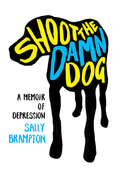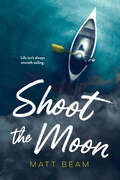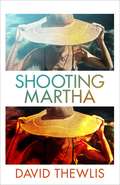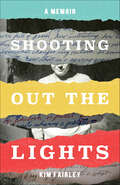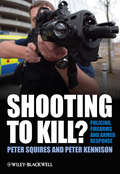- Table View
- List View
Shelter: Homelessness in Our Community (Orca Think #2)
by Lois PetersonThere are 150 million people experiencing homelessness worldwide, and that number is increasing every year. Homelessness is not a choice, yet it exists in almost every community. But why are people homeless? Who are they? What can you do? In Shelter: Homelessness in Our Community, readers will get answers to these complex questions. They’ll learn about the root causes of homelessness and its effects, and what people and organizations around the world are doing to address the problem. It shares the personal stories of people who live on the street and the adults and kids who work with them. As a former homeless-shelter worker, author Lois Peterson encourages young people to approach the issue with knowledge and compassion. She dispels some of the myths about homelessness and makes the case for why everyone deserves a safe, permanent place to call home.
Shift into Freedom: The Science and Practice of Openhearted Awareness
by Loch KellyShift into Freedom presents innovative teacher Loch Kelly's training manual for actively participating in the evolution of your own consciousness. Synthesizing insights from neuroscience and psychology with wisdom from the world's contemplative traditions, Shift into Freedom offers an accessible and remarkably powerful series of meditations that lead us to a little-known natural capacity called "awake awareness. " Through an unfolding process of "small glimpses, many times," these exercises shift us from a thought-based knowing to an awareness-based way of operating in the world. With continued practice, we learn to "unhook" from our customary home in our ego-based identity--and then sustain an embodied presence and relatedness known as "open-hearted awareness. " Loch Kelly teaches that this is "the meeting place of awakening and growing up, where we have the capacity to handle a fully emotional, intimate life and act with authenticity and compassion. "
Shift: Managing Your Emotions--So They Don't Manage You
by Ethan Kross&“A revolutionary guide to mastering your emotional life.&”—Charles Duhigg&“Brilliant, engaging, and deeply insightful.&”—Lisa Damour&“A blueprint for navigating the emotional curveballs that life throws at us every day.&”—The New York TimesINSTANT NATIONAL BESTSELLER • One of Oprah Daily&’s Best Self-Help Books for Personal Growth in 2025, Next Big Idea Club&’s Highly Anticipated Books, and Adam Grant&’s 10 New Books to Feed Your MindA myth-busting, science-based guide that addresses the timeless question of how to manage your emotional life using tools you already possess—from the bestselling author of Chatter.Whether it&’s anxiety about going to the doctor, boiling rage when we&’re stuck in traffic, or devastation after a painful break-up, our lives are filled with situations that send us spiraling. But as difficult as our emotions can be, they are also a superpower. Far from being &“good&” or &“bad,&” emotions are information. When they&’re activated in the right ways and at the right time, they function like an immune system, alerting us to our surroundings, telling us how to react to a situation, and helping us make the right choices. But how do we make our emotions work for us rather than against us? Acclaimed psychologist Dr. Ethan Kross has devoted his scientific career to answering this question. In Shift, he dispels common myths—for instance, that avoidance is always toxic or that we should always strive to live in the moment—and provides a new framework for shifting our emotions so they don&’t take over our lives. Shift weaves groundbreaking research with riveting stories of people struggling and succeeding to manage their emotions—from a mother whose fear prompted her to make a spur-of-the-moment decision that would save her daughter&’s life mid-flight to a nuclear code-carrying Navy SEAL who learned how to embrace both joy and pain during a hellish training activity. Dr. Kross spotlights a wide array of tools that we already have access to—in our bodies and minds, our relationships with other people, and the cultures and physical spaces we inhabit—and shows us how to harness them to be healthier and more successful. Filled with actionable advice, cutting-edge research, and riveting stories, Shift puts the power back into our hands, so we can control our emotions without them controlling us—and help others do the same.
Shifting: The Double Lives of Black Women in America
by Kumea Shorter-Gooden Ms. Charisse JonesCommemorating its 20th year in print with a new Introduction and updated content, Shifting explores the many identities Black women must adopt in various spaces to succeed in America. Based on the African American Women's Voices Project, Shifting reveals that a large number of Black women feel pressure to compromise their true selves as they navigate America's racial and gender bigotry. Black women "shift" by altering the expectations they have for themselves or their outer appearance. They modify their speech. They shift "white" as they head to work in the morning and "Black" as they come back home each night. They shift inward, internalizing the searing pain of the negative stereotypes that they encounter daily. And sometimes they shift by fighting back. In commemoration of its twentieth year in print with a new Introduction and updated content throughout Shifting is a much-needed, clear, and comprehensive portrait of the reality of Black women's lives today.
Shifts in the Field of Mathematics Education
by Peter Gates Robyn JorgensenProfessor Stephen Lerman has been a leader in the field of mathematics education for thirty years. His work is extensive, making many significant contributions to a number of key areas of research. Stephen retired from South Bank University in 2012, where he had worked for over 20 years, though he continues to work at Loughborough University. In this book several of his long standing colleagues and collaborators reflect on his contribution to mathematics education, and in so doing illustrate how some of Steve's ideas and interventions have resulted in significant shifts in the domain.
Shimamura's MARGE Model of Learning in Action (In Action)
by Nimish LadShimamura’s MARGE model, described as a ‘Whole-Brain Learning Approach for Students and Teachers’, builds links between the areas of neuroscience, cognitive science and the practice of classroom teachers. Through discussing key ideas within the learning process – Motivate, Attend, Relate, Generate and Evaluate – Shimamura’s MARGE is a valuable lens through which we can discuss learning.This book aims to bring the MARGE model to life through the use of case studies written by practising teachers, and examples taken from classrooms across a range of phases. Through taking each of the principles of MARGE in turn, this practical guide helps all teachers better understand how they can develop their practice and improve the impact they have with the students they teach.
Shimamura's MARGE Model of Learning in Action (In Action)
by Nimish LadShimamura’s MARGE model, described as a ‘Whole-Brain Learning Approach for Students and Teachers’, builds links between the areas of neuroscience, cognitive science and the practice of classroom teachers. Through discussing key ideas within the learning process – Motivate, Attend, Relate, Generate and Evaluate – Shimamura’s MARGE is a valuable lens through which we can discuss learning.This book aims to bring the MARGE model to life through the use of case studies written by practising teachers, and examples taken from classrooms across a range of phases. Through taking each of the principles of MARGE in turn, this practical guide helps all teachers better understand how they can develop their practice and improve the impact they have with the students they teach.
Shine Bright Anyway: 90 Affirmations That Declare You Are Enough When the World Says You're Not
by Faith Broussard CadeYou are enough! Learn to acknowledge your wounds, embrace healing, and shine bright again with these 90 insightful and uplifting messages from Faith Broussard Cade (@fleurdelisspeaks on Instagram).The expectations we feel from others today can make us feel that we are not enough. That we should want more, do more, and be more.After a car accident in 2018 that left her with a traumatic brain injury that she still deals with today, author Faith Broussard Cade was in a place of trauma and brokenness. To this day, it hurts, it slows her down, and some days it leaves her feeling emotionally vulnerable and overwhelmed.But despite this suffering every day she chooses gratitude, love, and hard work. Faith's hand-penned notes sharing about her struggles on her Instagram account, @fleurdelisspeaks, has helped thousands of others do the same. And in this beautiful, full-color book she pairs each handwritten note with a longer message of encouragement to help you or someone you care about:Overcome the wounds of the past through honesty and humblenessReplace feelings of inadequacy with the truth of your worthinessPrioritize self-care even when life is demandingCelebrate each day with gratitude and appreciationBelieve in yourself when others say you can't or that you don't matter If life has left you feeling you are not enough or you are haunted by past choices, circumstances, or labels, Shine Bright Anyway will give you the encouragement to change your narrative. The expectations you live with today do not have to define you. You are enough!
Shining a Light on the Autism Spectrum: Experiences and Aspirations of Adults
by Debra Costley Susanna Baldwin Susan Bruck Kaaren Haas Kerry RitzrowProduced in conjunction with Autism Spectrum Australia (Aspect), Australia’s largest provider of services with people on the autism spectrum, this new text explores the experiences, needs and aspirations of adults on the spectrum. The volume utilises the structure of a recent survey (the only one of its type in Australia and one of few conducted internationally) and presents data from the study with contributions from adults on the spectrum to illustrate the findings with first person accounts and case studies. By drawing on these unique experiences, this valuable resource is presented in a way that will be both engaging and accessible for a wide range of readers.
Shining a Light on the Autism Spectrum: Experiences and Aspirations of Adults
by Debra Costley Susanna Baldwin Susan Bruck Kaaren Haas Kerry RitzrowProduced in conjunction with Autism Spectrum Australia (Aspect), Australia’s largest provider of services with people on the autism spectrum, this new text explores the experiences, needs and aspirations of adults on the spectrum. The volume utilises the structure of a recent survey (the only one of its type in Australia and one of few conducted internationally) and presents data from the study with contributions from adults on the spectrum to illustrate the findings with first person accounts and case studies. By drawing on these unique experiences, this valuable resource is presented in a way that will be both engaging and accessible for a wide range of readers.
Shiny Objects: Why We Spend Money We Don't Have in Search of Happiness We Can't Buy
by James A. RobertsIn Shiny Objects, a cross between In Praise of Slowness and The Tipping Point, consumer behavior expert Professor James A. Roberts takes us on a tour of America's obsession with consumerism—pointing out its symptoms, diagnosing specific problems, and offering a series of groundbreaking solutions.Roberts gives practical advice for how to correct the materialistic trends in our lives which lock us into a cycle of financial hardship and stress. Shiny Objects, a new The Paradox of Choice for the modern reader, is more than a critique of capitalism—it's also an exploration into how we can live happier, fuller, more productive lives today.
Ship of Thought: Essays on Psychoanalysis and Learning (The Encyclopaedia of Psychoanalysis)
by Duncan BarfordLearning is the most basic means by which we can change oursleves. Of all the activities of the mind, learning is perhaps the most fundamental, yet one of the most provocative and difficult to understand. In this fourth volume of the Encyclopaedia of Psychoanalysis, ten new essays by an interdisciplinary array of educationalists, psychoanalysts and academics confront head-on the many problems associated with the mystery of learning. What is learning? How are ideas 'transmitted' from the mind of one person to the mind of another? What makes a good teacher? Like all the preceding volumes in The Encyclopaedia of Psychoanalysis, ideas and opinions are presented from a contrasting variety of viewpoints within contemporary psychoanalytic theory. Individual chapters are devoted to the theories of learning implicit in the work of Freud, Jung, Klein, Bion, Winnicott, and Lacan. Other topics explored in this extremely comprehensive and thought-provoking collection include: how to teach 'psychoanalytically'; the relationship between learning difficulty and 'writer's block'; and the problems inherent in teaching psychoanalysis itself.
Shitstorms, Lügen, Sex: Steinzeitrituale in Gruppen und Hierarchien
by Gerhard SchwarzIst es Ihnen auch schon passiert, dass Sie im Aufzug auf den Knopf für das siebte Stockwerk gedrückt hatten, aber im fünften Stockwerk ausstiegen, weil alle anderen ausstiegen? Sie fahren nur dann weiter, wenn Sie diesen unbewussten Drang überwinden und sich mithilfe Ihrer Vernunft überlegen, dass Sie eigentlich in das siebente Stockwerk wollen. Der Drang, mit den anderen zusammen auszusteigen, ist ein archaisches Muster, das einstmals in der Steinzeit den Sinn hatte (und meist bis heute noch hat), in einer Gruppe, zu der Sie immerhin vom Erdgeschoss bis zum fünften Stockwerk gehörten, ein einheitliches Verhalten herzustellen. Gruppen, die diesen Konformitätsdruck nicht entwickeln, haben geringere Erfolgschancen als solche, denen es gelingt, ihre Mitglieder „gleichzuschalten“. Sigmund Freud nannte vor 100 Jahren diesen Drang des Individuums, Gruppenverhalten nachzuahmen „unbewusst“. Die moderne Gehirnforschung gibt ihm weitgehend recht. Auch die Gruppendynamik erkennt immer mehr solcher unbewussten Verhaltensmuster, die plötzlich in Gruppen auftreten und meist alle Mitglieder der Gruppe mit einbeziehen. Eine Gruppe kann sich dann auch ganz „irrational“ verhalten und Handlungen setzen, die ihr später – wieder bei vollem Bewusstsein – leidtun. Denn Gruppen – und nicht nur sie – verhalten sich nicht immer rational. Unter bestimmten Bedingungen geht die Vernunft verloren und es greifen archaische Muster. Die Psychologie verwendet dafür das Wort „Regression“, was eigentlich „Rückfall“ bedeutet. Aber wohin fallen wir zurück?Videos per App: Laden Sie die Springer Nature More Media kostenlos herunter - Abbildungen im Buch per App mit Handy oder Tablet scannen, um Videos zu streamen.
Shock
by Larry Tye Kitty DukakisKitty Dukakis has battled debilitating depression for more than twenty years. Coupled with drug and alcohol addictions that both hid and fueled her suffering, Kitty?s despair was overwhelming. She tried every medication and treatment available; none worked for long. It wasn?t until she tried electroconvulsive therapy, or ECT, that she could reclaim her life. Kitty?s dramatic first-person account of how ECT keeps her illness at bay is half the story of Shock. The other half, by award winning medical reporter Larry Tye, is an engrossing look at the science behind ECT and its dramatic yet subterranean comeback. This book presents a full picture of ECT, analyzing the treatment?s risks along with its benefits. ECT, it turns out, is neither a panacea nor a scourge but a serious option for treating life threatening and disabling mental diseases, like depression, bipolar disorder, and others. Through Kitty Dukakis?s moving narrative, and interviews with more than one hundred other ECT patients, Shock: The Healing Power of Electroconvulsive Therapy separates scare from promise, real complications from lurid headlines. In the process Shock offers practical guidance to prospective patients and their families, boldly addressing the controversy surrounding ECT and awakening millions to its capacity to heal.
Shock Therapy: Psychology, Precarity, and Well-Being in Postsocialist Russia
by Tomas MatzaAfter the collapse of the Soviet Union, Russia witnessed a dramatic increase in psychotherapeutic options, which promoted social connection while advancing new forms of capitalist subjectivity amid often-wrenching social and economic transformations. In Shock Therapy Tomas Matza provides an ethnography of post-Soviet Saint Petersburg, following psychotherapists, psychologists, and their clients as they navigate the challenges of post-Soviet life. Juxtaposing personal growth and success seminars for elites with crisis counseling and remedial interventions for those on public assistance, Matza shows how profound inequalities are emerging in contemporary Russia in increasingly intimate ways as matters of selfhood. Extending anthropologies of neoliberalism and care in new directions, Matza offers a profound meditation on the interplay between ethics, therapy, and biopolitics, as well as a sensitive portrait of everyday caring practices in the face of the confounding promise of postsocialist democracy.
Shock Waves: A Practical Guide to Living with a Loved One's PTSD
by Cynthia OrangeA user-friendly guide to helping a loved one with post-traumatic stress disorder--while taking care of yourself.In the United States, about 60 percent of men and 50 percent of women experience, witness, or are affected by a traumatic event in their lifetimes. Many of them (8 percent of men and 20 percent of women) may develop post-traumatic stress disorder (PTSD)--a life-altering anxiety disorder. Once connected mainly with veterans of war, PTSD is now being diagnosed in many situations that cause extreme trauma such as rape, physical attacks or abuse, accidents, terrorist incidents, or natural disasters. The millions of family members of those who have PTSD also suffer, not knowing how to help their loved one recover from the pain.Shock Waves is a practical, user-friendly guide for those who love someone suffering from this often debilitating anxiety disorder, whether that person is a survivor of war or of another harrowing situation or event. Through her own experience, extensive research, advice from mental health professionals, and interviews with those working through PTSD and their families, Cynthia Orange shows readers how to identify what PTSD symptoms look like in real life, respond to substance abuse and other co-occurring disorders, manage their reactions to a loved one's violence and rage, find effective professional help, and prevent their children from experiencing secondary trauma.Each section of Shock Waves includes questions and exercises to help readers incorporate the book's lessons into their daily lives and interactions with their traumatized loved ones
Shoes, Glues and Homework: Dangerous Work in the Global Footwear Industry (Work, Health and Environment Series)
by Robert Forrant Charles Levenstein John Wooding Pia MarkkanenFirst Published in 2017. Routledge is an imprint of Taylor & Francis, an Informa company.
Shoot for the Moon: How the Moon Landings Taught us the 8 Secrets of Success
by Richard Wiseman'Fascinating new book examines the history of Nasa's Apollo space missions' Daily Mail_______Eight key lessons to revolutionise your life with the mindset that got man to the moon.20th July 1969: Neil Armstrong becomes the first person to walk on the Moon. We all recognize this to be one of mankind's greatest achievements. Yet what did it take to make John F. Kennedy's dream a reality?In this remarkable book, Professor Richard Wiseman presents a pioneering study of the mindset that took humanity to the Moon, and shows how you can harness and use it to achieve the extraordinary in your everyday life.Combining personal interviews, mission archives and cutting-edge psychology, Wiseman embarks on the ultimate voyage through inner space. Along the way he identifies eight key principles that make up the Apollo Mindset, including how pessimism is crucial to success, and how fear and tragedy can be transformed into hope and optimism. You will discover a series of practical techniques that you can use to incorporate these winning principles into both your professional and personal life. Whether you want to start a business venture, change careers, find your perfect partner, raise a loving family, get promoted, gain a new qualification, escape the rat race, or pursue a lifelong passion, these techniques will help you to reach your own Moon.
Shoot for the Moon: How the Moon Landings Taught us the 8 Secrets of Success
by Richard Wiseman20th July 1969: Neil Armstrong becomes the first person to walk on the Moon. We all recognize this to be one of mankind's greatest achievements. Yet what did it take to make John F. Kennedy's dream a reality?In this remarkable book, Professor Richard Wiseman presents a pioneering study of the mindset that took humanity to the Moon, and shows how you can harness and use it to achieve the extraordinary in your everyday life.Combining personal interviews, mission archives and cutting-edge psychology, Wiseman embarks on the ultimate voyage through inner space. Along the way he identifies eight key principles that make up the Apollo Mindset, including how pessimism is crucial to success, and how fear and tragedy can be transformed into hope and optimism. You will discover a series of practical techniques that you can use to incorporate these winning principles into both your professional and personal life. Whether you want to start a business venture, change careers, find your perfect partner, raise a loving family, get promoted, gain a new qualification, escape the rat race, or pursue a lifelong passion, these techniques will help you to reach your own Moon.(P)2019 Quercus Editions Limited
Shoot the Damn Dog: A Memoir of Depression
by Sally BramptonA searing, raw memoir of depression that is ultimately uplifting and inspiring. A successful magazine editor and prize-winning journalist, Sally Brampton launched Elle magazine in the UK in 1985. <P><P>But behind the successful, glamorous career was a story that many of her friends and colleagues knew nothing about--her ongoing struggle with severe depression and alcoholism. Brampton's is a candid, tremendously honest telling of how she was finally able to "address the elephant in the room," and of a culture that sends the overriding message that people who suffer from depression are somehow responsible for their own illness. <P><P>She offers readers a unique perspective of depression from the inside that is at times wrenching, but ultimately inspirational, as it charts her own coming back to life. Beyond her personal story, Brampton offers practical advice to all those affected by this illness. <P><P>This book will resonate with any person whose life has been haunted by depression, at the same time offering help and understanding to those whose loved ones suffer from this debilitating condition.
Shoot the Moon (Orca Soundings)
by Matt BeamSixteen-year-old Charlie Abbott lives with her father, a once-brilliant mathematician subject to mood swings and depressive episodes. Making sure her dad gets out of bed and takes his meds is part of Charlie's daily routine, but lately she’s been distracted by her crush, Lachlan. Her grades are slipping and her mom is starting to ask questions. When Lachlan finally asks her out, Charlie is over the moon—until she realizes that her father has disappeared. With only a note to go on, Charlie begins to retrace her father’s steps. Along the way, she meets people who help her understand not only where he might be but also who he really is. As she discovers the truth, her search takes on greater urgency and scope. This short novel is a high-interest, low-reading level book for teen readers who are building reading skills, want a quick read or say they don’t like to read! The epub edition of this title is fully accessible.
Shooting Ghosts: A U.S. Marine, a Combat Photographer, and Their Journey Back from War
by Thomas J. Brennan Finbarr O'Reilly"A majestic book." --Bessel van der Kolk, MD, author of The Body Keeps the ScoreA unique joint memoir by a U.S. Marine and a conflict photographer whose unlikely friendship helped both heal their war-wounded bodies and soulsWar tears people apart, but it can also bring them together. Through the unpredictability of war and its aftermath, a decorated Marine sergeant and a world-trotting war photographer became friends, their bond forged as they patrolled together through the dusty alleyways of Helmand province and camped side by side in the desert. It deepened after Sergeant T. J. Brennan was injured during a Taliban ambush, and both returned home. Brennan began to suffer from the effects of his injury and from the fallout of his tours in Iraq and Afghanistan. But war correspondents experience similar rates of posttraumatic stress as combat veterans. The causes can be different, but guilt plays a prominent role in both. For Brennan, it’s the things he’s done, or didn’t do, that haunt him. Finbarr O’Reilly’s conscience is nagged by the task of photographing people at their most vulnerable while being able to do little to help, and his survival guilt as colleagues die on the job. Their friendship offered them both a shot at redemption. As we enter the fifteenth year of continuous war, it is increasingly urgent not just to document the experiences of the battlefield but also to probe the reverberations that last long after combatants and civilians have returned home, and to understand the many faces trauma takes. Shooting Ghosts looks at the horrors of war directly, but then turns to a journey that draws on our growing understanding of what recovery takes. Their story, told in alternating first-person narratives, is about the things they saw and did, the ways they have been affected, and how they have navigated the psychological aftershocks of war and wrestled with reforming their own identities and moral centers. While war never really ends for those who’ve lived through it, this book charts the ways two survivors have found to calm the ghosts and reclaim a measure of peace.
Shooting Martha
by David Thewlis'A riotously good novel, witty and earnest, brimming with sharply drawn characters and creeping suspense. David Thewlis is a fabulous writer' Anna Bailey, Sunday Times bestselling author of Tall BonesCelebrated director Jack Drake can't get through his latest film (his most personal yet) without his wife Martha's support. The only problem is, she's dead...When Jack sees Betty Dean - actress, mother, trainwreck - playing the part of a crazed nun on stage in an indie production of The Devils, he is struck dumb by her resemblance to Martha. Desperate to find a way to complete his masterpiece, he hires her to go and stay in his house in France and resuscitate Martha in the role of 'loving spouse'.But as Betty spends her days roaming the large, sunlit rooms of Jack's mansion - filled to the brim with odd treasures and the occasional crucifix - and her evenings playing the part of Martha over scripted video calls with Jack, she finds her method acting taking her to increasingly dark places. And as Martha comes back to life, she carries with her the truth about her suicide - and the secret she guarded until the end.A darkly funny novel set between a London film set and a villa in the south of France.A mix of Vertigo and Jonathan Coe, written by a master storyteller.PRAISE FOR DAVID THEWLIS'S FICTION 'David Thewlis has written an extraordinarily good novel, which is not only brilliant in its own right, but stands proudly beside his work as an actor, no mean boast' Billy Connolly'Hilarious and horror-filled' Francesca Segal, Observer'A fine study in character disintegration... Very funny' David Baddiel, The Times'Exquisitely written with a warm heart and a wry wit... Stunning' Elle'Queasily entertaining' Financial Times'A sharp ear for dialogue and a scabrously satiric prose style' Daily Mail'Laugh-out-loud, darkly intelligent' Publishers Weekly'This is far more than an actor's vanity project: Thewlis has talent' Kirkus
Shooting Out the Lights: A Memoir
by Kim FairleyKim Fairley was twenty-four when she fell in love with and married a man who was fifty-seven. Something about Vern—his quirkiness, his humor, his devilish smile—made her feel an immediate connection with him. She quickly became pregnant, but instead of the idyllic interlude she’d imagined as she settled into married life and planned for their family, their love was soon tested by the ghosts of Vern’s past—a town, a house, a family, a memory. Shooting Out the Lights is a real-life mystery that explores the challenges faced in a loving marriage, the ongoing, wrenching aftermath of gun violence and the healing that comes with confronting the past.
Shooting to Kill
by Peter Kennison Peter SquiresShooting to Kill? Policing, Firearms and Armed Response explores the dilemma of armed response policing in the UK, and policing in a gun culture. Offers the first critical exploration of the ACPO code of guidance on Police Use of Firearms and other tactical manualsIncludes interviews with senior police firearms managers and critical case studies of police firearms incidentsFeatures the first in-depth, academic analysis of the Stockwell shooting incident and the Kratos policyProvides a review of key developments in armed response policing around the worldDescribes the crucial phases in armed response policy development in Britain and explores the consequences of arming the police
